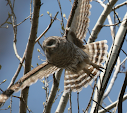
A-Boo!
I went back to a Boulder favorite last evening, Gregory Canyon, in search of a reported rare resident the Scarlet Tanager. Unfortunately for me I missed it, but then I will be more likely to make special trips back to that great area if I have a carrot on a stick in front of me. Especially a brilliant red carrot with black trim.
Even missing the Scarlet couldn't keep this goldmine from producing though. I had three life birds, one of which posed for a respectable picture, and two will be hunted again in the future.
The good:
 Western Tanager.
Western Tanager.And the - through no fault of its own - ugly:
The sad part on that one is; that I have an even less focused shot that shows the yellow undertail coverts which helped me make the ID. My next frame had the perching branch in focus as the bird had just dove down the length of the tree and behind a larger clump of branches. I guess I'll just have to get faster on the focusing draw.

To finish on a cleaner note here are two better picks of more common species, a Turkey Vulture circling in the sunlight (there were 8 in the kettle), and a Spotted Towhee on what I believe is a Raspberry branch. Should be good bear and bird food later this summer!

Fortunately on this trip there were no snakes visible whatsoever. Really, it is much nicer that way.

To finish on a cleaner note here are two better picks of more common species, a Turkey Vulture circling in the sunlight (there were 8 in the kettle), and a Spotted Towhee on what I believe is a Raspberry branch. Should be good bear and bird food later this summer!

Fortunately on this trip there were no snakes visible whatsoever. Really, it is much nicer that way.
2009 Count: 150
Lifetime:163



















































